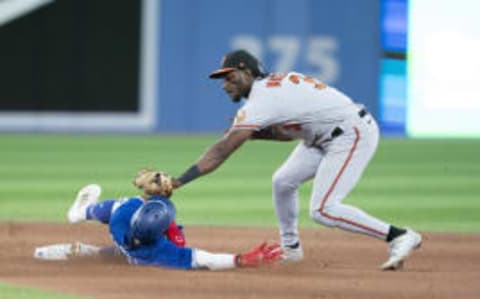Blue Jays First Half Disappointments

Sep 2, 2014; St. Petersburg, FL, USA; Toronto Blue Jays manager John Gibbons (5) in the dugout against the Tampa Bay Rays at Tropicana Field. Mandatory Credit: Kim Klement-USA TODAY Sports
The Blue Jays limped into the all-star break, going 4-8 in their 12 July games, falling 4.5 games back of the New York Yankees. The break gives the team a chance to reset for a big playoff push, as the AL East and wild card spots are very much up for grabs.

Toronto Blue Jays
While the break serves as a chance to look ahead, and leave the entertaining yet inconsistent and at times frustrating first half behind us, it also gives us time to reflect on some performances that left much to be desired. Those performances, mixed in with many success stories and surprises, will need to find a way to resurrect themselves if the Jays want to contend in the second half.
The list of individual first half disappointments is small. It was disappointing to see Michael Saunders unable to perform at his peak ability due to injury, but it was hardly a performance issue. It’s tough to call R.A. Dickey a disappointment, despite the fact that he has some numbers similar to that of Drew Hutchison, because the expectations coming into the year were far different for both players.
The bullpen was shaky at times, but has been relatively solid the entire year. Surprise performances from Roberto Osuna, Liam Hendriks, Bo Schultz, and a return to form from Steve Delabar have really helped the bullpen. It’s tempting to call Brett Cecil and Aaron Loup disappointments, but I wasn’t as quick to pull that trigger as many others would be. Both have had their rough patches, but they’ve delivered in some important spots as well, and their respective underlying peripherals suggest they haven’t been as bad as some people make it out to be.
Regardless, there have been some disappointments throughout the first half and I’ll outline the players I believe that deserve that distinction.
Next: The Chicken Wing is Missing Some Sauce
May 12, 2015; Baltimore, MD, USA; Toronto Blue Jays first baseman Edwin Encarnacion (10) celebrates with designated hitter Jose Bautista (19) after hitting a home run in the seventh inning against the Baltimore Orioles after at Oriole Park at Camden Yards. Mandatory Credit: Tommy Gilligan-USA TODAY Sports
Perhaps you might see Edwin’s name and take a quick look at his 18 HR and 54 RBI and wonder why, but you need to take a deeper look into Edwin’s numbers to see how he’s truly been a disappointment in the middle of this behemoth offence.
Live Feed class=inline-text id=inline-text-3
Birds Watcher
Maybe Edwin’s performance isn’t so much a disappointment as it is the reality of declining performance. That could very much be the case, but nonetheless, he’s been a shadow of the hitter he was throughout the 2012, 2013, and 2014 campaigns.
Edwin’s slash rate of .233/.326/.452 is clearly below expectations and much lower than last year’s .268/.354/.547, seeing his OPS drop a whopping 123 points. His wRC+ has had 36 points chopped off, currently sitting at 114 down from 150 in 2014, making him closer to a league average hitter rather than the premier slugger we’ve seen for the previous three years.
His walk rate is a steady 11.5%, right in line with what he did last year, which shows his plate discipline is still a strong point. His strikeout is up 3%, which might not seem like a whole lot, but it’s raised his K% to 18%, the highest it’s been since his 2009 season.
His batted ball profile remains largely the same in terms of line drives, ground balls, and fly balls, and his infield fly % is up, but it’s his hard contact rate that leaves room for concern. His hard contact rate is down to 27.5%, which ranks him 110th out of 162 qualified hitters. Last year, his hard contact rate was 38.1%, ranking him 18th out of 146 qualified hitters. It’s a sudden and significant drop, and can’t be blamed on a small sample size.
This severe reduction in hard contact undoubtedly have a negative effect on his ISO and BABIP, which have dropped 39 and 29 points respectively, contributing to a poor slash rate.
Another area of disappointment, or concern, depending on whether you’re looking at his first half as a disappointment or declining performance, are his contact rates.
The amount he’s swinging at balls outside of the strike zone is nearly the same as last year and right in line with his career rate, correlating with his steady walk rate. However, he’s swinging at pitches inside the zone more often, 65.2% in 2015 compared to 61.2% in 2014, which you’d think would serve as a good ting, but his contact rate on pitches inside the zone is down, 84.4% in 2015 compared to 88.4% in 2014.
This represents a hitter who is doing a good job of swinging at the right pitches, but simply isn’t hitting them as often or hitting them as hard as often. If it is indeed a reduction in performance because he’s declining, this really shouldn’t be a massive surprise, disappointing yes, but not surprising. This happens to aging players, maybe not this sudden, but it happens.
However, the raw power he’s always possessed is still there, showing he may be a hitter who may be experiencing a prolonged slump, someone who’s dealing with nagging injuries, or just isn’t seeing the ball well, leading to a disappointing first half.
According to the ESPN Home Run Tracker, the average distance of his home runs is 413.3 feet, which represents a career high and ranks him 7th in the league. He clearly can hit the ball a long way still and his power hasn’t disappeared, but the contact rates and hard hit rates need to improve for Edwin to have a stronger second half.
The average home run distance gives me hope he simply had a rough half of a season, which is a strong possibility, as opposed to truly slowing down as a hitter. It will be interesting to see if those hard hit and contact rates trend upwards in the second half. For the Jays, it would be a boost to their already monstrous offence.
Next: Is the #HutchShow Still On?
Jul 3, 2015; Detroit, MI, USA; Toronto Blue Jays starting pitcher Drew Hutchison (36) walks off the field after being relieved in the fifth inning against the Detroit Tigers at Comerica Park. Mandatory Credit: Rick Osentoski-USA TODAY Sports
Drew Hutchison
Hutchison poses as an interesting player to pick on here, as he’s kind of the opposite of Edwin in a sense. Edwin, who clearly had a disappointing first half, still produced 18 HR and 54 RBI. By traditional standards, that’s not something to scoff at. But his underlying numbers, peripherals and advanced stats suggested something completely different.
With Hutch, it’s the other way around. His 5.33 ERA and 1.49 WHIP are an eye sore, yet his peripherals, and the advanced stats suggest he’s actually improving. Mind you, there are some numbers suggesting he has a lot of work to do.
Of course, that 5.33 ERA and 1.49 WHIP are unacceptable, especially for the guy who needed to be the team’s best pitcher after Marcus Stroman went down in spring training. Deservedly, or undeservedly so, he was given that title, and he’s failed to come close to expectations.

Toronto Blue Jays
He entered the year coming off a relatively strong 24-year-old season, and a very strong end to that season. He seemed ready to take the next step and become a mainstay in the Jays rotation, but he’s done far from that.
The aforementioned peripheral and advanced stats show some light at the end of the tunnel. His K/9 hasn’t gone up, but it’s a strong 8.36, BB/9 has gone down to 2.76, and his HR/9 has gone down as well to 0.92/9. This has led a FIP of 3.65 and an xFIP of 3.78, suggesting he’s due for some success in the second half. If his ERA were around that number, no one would be complaining. But, it’s not.
His BABIP has inflated from .293 last year to .358 this year. Part of that can be attributed to luck, but you also need to consider a number of different things when looking that number.
His line drive rate is sitting 25.6%, up from 18.6% a year ago. That’s far too many line drives, and when coupled with a hard contact rate of 31.4%, your BABIP is bound to be inflated. Respectively, that line drive rate and hard contact rate rank him 95th and 78th out of 97 qualified starting pitchers. Those simply aren’t good enough and won’t lead to success despite the strong walk and strikeout numbers.
It would take a deeper look into pitch usage vs situation, pitch location, pitch movement, etc. to be able to identify why those rates are where they’re currently at, but in terms of judging based on what you see, he’s catching far too much of the plate and he’s getting burnt for it time and time again.
Another issue leading to inconsistent results is his repertoire. He’s essentially a two pitch pitcher against right-handed hitters, which is fine when his good stuff is on and his slider is a legit swing and miss offering like it was late last year. But when it isn’t, he’s getting hammered. Against left-handed hitters he mixes a change, but it hasn’t been as effective as his whiff percentage on the change is down over five percentage points.
More from Toronto Blue Jays News
- Blue Jays: Adam Cimber, the unlikely decision King
- Toronto Blue Jays: Has the Shift Killed Kevin Gausman’s 2022 Cy Young Hopes?
- Blue Jays: What Yusei Kikuchi’s latest stumble should mean
- Blue Jays: Alek Manoah on pace to succeed in possible postseason
- Blue Jays: Bradley Zimmer has carved himself a valuable role
His repertoire isn’t diverse enough to be able to handle his inconsistency so far. Craig Edwards from Fangraphs outlined his inconsistent performance and pitch repertoire earlier in the year, and as he explained, Hutch needs his good fastball to effective. If he can’t consistency with that pitch the struggles will continue, unless he can regain the slider he had late last year that allowed him to strikeout hitters in bunches, or become confident in his changeup to use it more often.
Another thing to note from Hutch is that his RHH/LHH and Home/Road splits have flipped this year. It’s rather perplexing, and something to keep an eye on in the second half.
There are some good signs from Hutch, but those only go so far. After a very disappointing first half he needs to rebound and start delivering consistent quality starts for the Jays. He’s gone 6 IP or more in only 7 of his 18 starts, unacceptable for a starter on a team that wants to contend. He doesn’t need to dominate every start, but 6-7 IP while allowing 2-4 runs will allow this offence to win the majority of his starts, and that’s all they need from him.
Next: The Van Guy is Struggling
Apr 19, 2015; Toronto, Ontario, CAN; Toronto Blue Jays starting pitcher Daniel Norris (32) throws a pitch during first inning in a game against the Atlanta Braves at Rogers Centre. Mandatory Credit: Nick Turchiaro-USA TODAY Sports
At the time of Norris’ demotion, I was in the boat that wanted to see him get 2-3 more starts at the major league level. Yea, he struggled, but he showed in Tampa Bay on April 25th what he was capable of, and I didn’t think he was given a legitimate shot to stick with the team, kind of like how Aaron Sanchez was.
Regardless, I’m not naming Norris as a disappointment because of how he performed in his short 5 start cameo to start the year, but because of how he’s pitched since going down to the minor leagues.

Toronto Blue Jays
The expectation at the time, or at least the hope of the Jays community, was that he would return to Buffalo for a period of time, make a number of starts, regain his confidence, get over his bout of ‘dead arm’, and return to the Jays in May or June and be a mainstay in the rotation for the rest of the year.
A situation similar to that of Stroman in 2014, but at this point, it looks like Norris will either be used as trade bait to acquire pitching that will help the Jays down the stretch, or spend the duration of the year in Buffalo, maybe getting a September call-up.
The expectations for him entering the year were too heavy, which is commonplace for top prospects, but to see him only spend 5 starts in the majors after the season he had in the minor leagues last year is truly disappointing. I’m making the assumption he doesn’t start another game for the Jays, but I can’t see that happening unless there’s significant injury problems or they’re out of it come September, which are two scenarios I don’t even want to think about considering.
More from Toronto Blue Jays News
- Blue Jays: Adam Cimber, the unlikely decision King
- Toronto Blue Jays: Has the Shift Killed Kevin Gausman’s 2022 Cy Young Hopes?
- Blue Jays: What Yusei Kikuchi’s latest stumble should mean
- Blue Jays: Alek Manoah on pace to succeed in possible postseason
- Blue Jays: Bradley Zimmer has carved himself a valuable role
It’s not that he’s pitched terrible in the minor leagues, but he hasn’t been the dominant presence he was expected to be, and what he needed to be to get that call back up.
His numbers aren’t terrible by any means, his ERA is sitting at 4.12 after a start in which he went 4.2 IP with 6 ER. His K/9 isn’t at the level he posted in the minor leagues last year, but it’s a solid 8.48, and his walk rate has improved to 3.75, and he’s managed to limit the home run ball with a 0.61 HR/9.
However, it’s not the type of performance that renders a call up, and he’s been far too inconsistent in Buffalo for the Jays to consider him in the rotation at this point. His FIP in AAA is a solid 3.45, but he seems to continue taking one step forward followed by another step back.
Stroman’s performance in AAA after he got sent down is the type of performance Norris needed, but couldn’t deliver: 7 GS, 35.2 IP, 3.03 ERA, 2.20 FIP, 11.36 K/9, 2.27 BB/9.
The kid is 22, so it really shouldn’t be shocking to see him struggling. His performance has been disappointing, but the entire situation really has been as well. Prospects are exciting, and to see Norris struggle at two levels in a season where he was expected to make an impact is nothing more than disappointing.
Next: Toronto Blue Jays Minor League All-Stars
More from Jays Journal
- Blue Jays: Adam Cimber, the unlikely decision King
- Toronto Blue Jays: Has the Shift Killed Kevin Gausman’s 2022 Cy Young Hopes?
- Blue Jays: What Yusei Kikuchi’s latest stumble should mean
- Blue Jays: Alek Manoah on pace to succeed in possible postseason
- Blue Jays: Bradley Zimmer has carved himself a valuable role